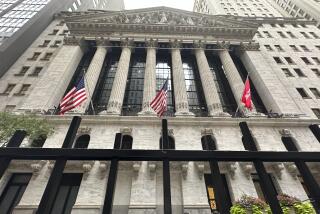Stocks Skyrocket on Hopes for Relief on Interest Rates
The stock market’s historic rally gained strength Tuesday amid investor hopes for an imminent cut in interest rates as the Dow Jones industrial average made its biggest leap in eight months to set another record high.
Less than 24 hours after it rushed past the 5,300 level for the first time, the Dow Jones industrial average neared 5,400 by soaring 76.23 points. It was the widely watched measure’s biggest one-day point gain since May 31, 1995, and its fifth record high in the past seven sessions. The Dow ended the day at 5,381.21.
Investors bid stocks higher on expectations that the Federal Reserve Board’s policy-making panel, which is ending a two-day meeting today in Washington, will vote to shave interest rates further to bolster the sluggish national economy.
The central bank did just that only a month ago, which cheered investors then and helped cap a remarkable 1995 in the financial markets that saw key stock indexes gain 30% or more.
But data released since December--including two reports on retail sales and consumers’ confidence that were announced Tuesday--have signaled continued weakness in the economy. So investors are betting that the Federal Reserve panel, called the Federal Open Market Committee (FOMC), will reduce rates yet again.
“Everybody is looking for the Fed to cut” rates, said Peter Canelo, chief market strategist at Natwest Securities in New York. “The bond market in particular thinks the economy is in bad shape.”
Even so, some major U.S. corporations have continued to report profits that have pleasantly surprised Wall Street--and that’s helping propel the stock market as well.
The latest example came Tuesday when General Motors Corp., the nation’s largest industrial enterprise, posted a 19% increase in fourth-quarter earnings to a record $1.9 billion, exceeding analysts’ forecasts.
The stock market also has drawn strength from Main Street because investors lately have plowed a record amount of fresh cash into mutual funds that invest in U.S. stocks. The funds’ managers, in turn, naturally put that money to work by purchasing more shares.
However, it’s the prospect of another round of interest-rate cuts and the economy’s sluggishness that are mostly lifting the stock market.
Lower rates help stocks in a number of ways. They make it less costly for businesses to buy new equipment and to build new plants. They make stocks a more attractive investment than savings accounts or money market funds. They often prompt consumers to borrow to buy more products and services. And they reduce corporate borrowing costs in the credit markets.
Indeed, prices of bond trading in the credit markets also have been rising, and their yields have been falling, on investors’ assumption that interest rates will keep declining. The yield on a 30-year Treasury bond, for example, dropped to within a whisker of the 6% level Tuesday, closing at 6.04%.
Expectations of another rate cut gained strength Tuesday after the Commerce Department reported that U.S. retail sales during December rose a meager 0.3% from November, despite the busy holiday shopping season. That followed actual sales declines in the fall. And January’s severe winter storms continued the hard times for retailers.
In addition, the Conference Board--a private business research group--said its index measuring consumers’ confidence in the economy plunged 12 points in January to 87, the lowest level since it stood at 86.7 in March 1994.
The reports further convinced many investors that the Fed panel will vote to trim the federal funds rate, which now stands at 5.5%, by one-quarter or one-half a percentage point. The rate is the one banks use when lending to each other overnight. It’s a rate that the central bank can immediately influence and therefore trigger cuts in other lending costs throughout the economy.
“A timely cut in rates . . . would both address past softness and serve as a preemptive strike against further fragility” in the economy, said economist Rosanne Cahn of the investment firm CS First Boston in New York. She warned that January’s retail sales also will be weak because of extremely poor weather that kept shoppers at home.
The Federal Reserve has been reducing interest rates over the past 12 months because its previous argument against doing so--that it would overheat the economy and rekindle high inflation--no longer applies, analysts said.
Inflation did loom as a threat two years ago when Fed Chairman Alan Greenspan and other Federal Reserve Board members initiated a series of seven interest-rate hikes to cool economic growth.
But even with inflation tamed, not everyone expects the Fed to cut rates again today. A failure to do so could cause stocks to tumble, at least in the short term.
John R. Williams, chief global markets economist at Bankers Trust New York Corp., asserted that the central bank still does not have enough economic data to indicate whether another rate decrease is needed. That’s partly because of the recent East Coast blizzard and federal government shutdown, which delayed publication of some key economic statistics.
Williams also noted that after the Fed pared rates last July, it waited five months before deciding to reduce them again in late December, and said it’s unlikely the panel will cut rates again so soon.
But regardless of what it does today, the Fed remains committed to easing interest rates so long as the economy shows subpar growth, and that posture remains a bullish factor for stock and bond markets, Williams said.
“This underlying trend is what’s driving the markets,” he said.
Times wire services contributed to this story.
More to Read
Inside the business of entertainment
The Wide Shot brings you news, analysis and insights on everything from streaming wars to production — and what it all means for the future.
You may occasionally receive promotional content from the Los Angeles Times.











